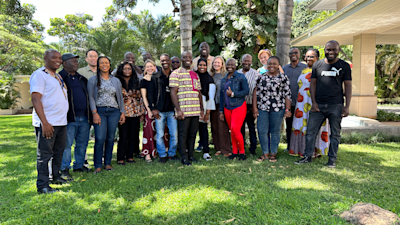Share with:

By Nissa Ramsey
Nissa is the founder of Think Social Tech(opens in new window), a research consultancy in the UK not-for-profit sector that delivers projects, provides practical and research support and supports organisations with learning. She also previously worked at Comic Relief.
This post was originally published by Nissa on Medium(opens in new window).
Work in Progress: Comic Relief, Esmée Fairbairn Foundation and the Clothworkers Foundation have recently announced their partnership to relaunch the Tech vs Abuse funding programme. I’ve been working in partnership with the funders, along with SafeLives and Snook to revisit the original Tech vs Abuse research and design challenges(opens in new window). Here, I want to explain a bit more about what we’re doing. Please get in touch, head to #techvsabuse on Twitter or comment below to contribute, or read on to find out more!
About the Tech vs Abuse Fund
The Tech Vs Abuse Fund is investing £600,000 into grants for UK not-for-profit organisations, to encourage technological innovation and creative digital solutions to improve the safety of women and girls affected by domestic abuse. As part of the programme, up to 12 funded partners will be offered a monetary award of up to £50,000 for twelve months alongside access to support from experts and advisors, plus the opportunity to collaborate and share learning with other organisations in the cohort.
This joint initiative is co-funded by Comic Relief, Esmée Fairbairn Foundation and the Clothworkers Foundation, funders with a history of supporting frontline services, strategic advocacy work and infrastructure in the domestic abuse sector (broadly defined). They are partnering to both facilitate and learn more about their role in enabling charities to increase the range of products and services accessible and available to the people they help, in an increasingly digital world. To kick start the process I’m partnering with SafeLives and Snook to re-visit the original Tech vs Abuse research and design challenges that shaped the fund (see https://techvsabuse.info(opens in new window))
The history
In 2016, I (working at Comic Relief at the time) partnered with Snook, Chayn and SafeLives to undertake a piece of research exploring what role digital technologies can play in helping to support people affected by domestic abuse. Together, we heard from over 250 people affected by domestic abuse and 350 support workers who help them, as well as looking for what tech solutions existed at the time. We used this collaborative research process to prioritise where technology could play the greatest role in helping address the identified needs and opportunities. NPC have subsequently written up a helpful guide to this form of user mapping techniques here as a way to involve service users in funding design). We identified 5 key priorities from the research where digital tools and services could help:
Based upon the research findings, Comic Relief, together with the research team and in consultation with a number of organisations in the domestic abuse sector, prioritised 5 key design challenges for funding:
Fifteen minute window: Provide or curate key information online for women experiencing domestic abuse in a way which is easy to find, simple to navigate and quick to interact with.
Effective real-time support services: Enable women to find and access services for support (including referrals) when required, day or night, seamlessly and with minimal logistical and emotional burden.
Safer digital-footprint: Provide people affected by domestic abuse and frontline professionals the confidence and knowledge they need to use technology and stay online safely, with full control over their online data, privacy settings and social media accounts.
Accessible legal and financial information: Create engaging, accessible and digestible information on the legal process or the financial situation women find themselves in, connecting to support and advice where relevant.
Realising it’s abuse: Use the creative opportunities of the web to raise awareness of what an abusive relationship looks like, provoking women and girls experiencing abuse to recognise this and get support.
The fund received over 60 applications and in partnership with the National Lottery Community Fund, funded 10 organisations to develop digital products and services. You can find out more about these here(opens in new window).
Revisiting the Design Challenges
Now the fund is ready to launch again, we’re undertaking sector focused discovery research to explore common priorities, problems and opportunities to better support those affected by abuse.
We’re talking to organisations developing digital products and services in this space and potential applicants, as well as those involved in the original research through a series of interviews and a creative workshop. We’re looking to find out:
What’s changed since 2016?
How do organisations see the role of tech in delivering services or support?
What is the current landscape of digital service provision in the domestic abuse sector?
What are the current gaps in service provision generally, either because of emerging needs, rising demand or reduction in services?
Are the design challenges still relevant and is it helpful to frame them as before? What other problems should we prioritise for tech to help address?
Our goal is to design the fund in a way which resonates with the challenges the sector wants to address for domestic abuse as a social issue (and within their organisations), aligned with the potential for the use of good digital and design approaches to solve these. We’re already half way through the research and we’re finding that:
The original research findings largely still stand today. The Design Challenges also feel relevant to those organisations developing their digital strategy and services. However, there could be some more effective ways to frame these and enable applicants to prioritise the problem they want to address for their target group
There are now more digital services provided by key sector organisations (compared to 2016), but people still aren’t finding the answers to their questions or the information and support they are looking for (there is a real gap in good SEO) online.
It is incredibly hard to prioritise any form of “digital” in this sector, whether that means training staff in how to safeguard against Tech Abuse, digitising processes to prevent people from re-telling their story or providing digital services to enable real time support (a useful description of different approaches to using digital can be found here). This could be because of a whole host of reasons, including a lack of confidence amongst frontline professionals in digital skills, a fear of what can go wrong (often based on experience), a hugely competitive funding environment and a lack of funding generally.
So far, I’ve been reassured of the potential value of early stage funding in a sector where capacity is low, the risks are high and funding structures, as well as availability prevent innovation. Moreover, it is crucial to develop better digital services for those experiencing or affected by abuse, to ensure people find what they are looking for, when and where they are looking for it, safely and easily.
Next steps…
This project will come to a conclusion by the end of May. If you would like to give your views or experiences please do get in touch, head to #techvsabuse on Twitter.
If you’re UK based looking for support or information related to domestic abuse please do head to Women’s Aid(opens in new window) or check the StandTall(opens in new window) directory for local services.
The second round of Tech vs Abuse funding will open for applications in late May. Prospective applicants should keep an eye on our funding opportunities page, where details and link to applications will be posted.
Visit the Tech vs Abuse(opens in new window) site for more information.

